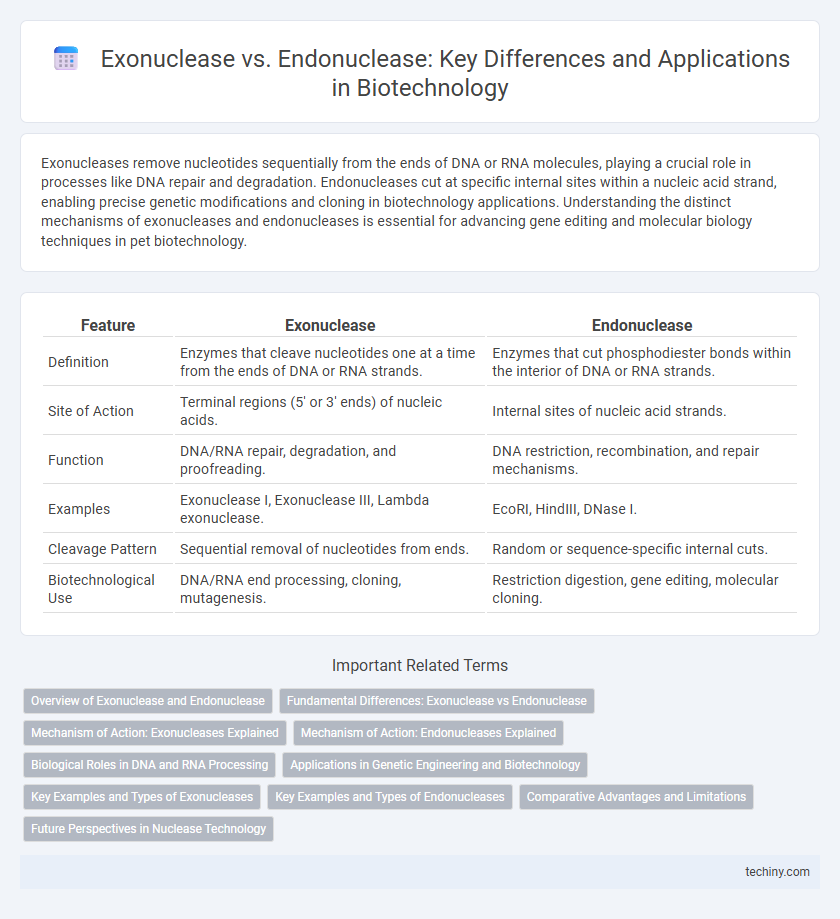Exonucleases remove nucleotides sequentially from the ends of DNA or RNA molecules, playing a crucial role in processes like DNA repair and degradation. Endonucleases cut at specific internal sites within a nucleic acid strand, enabling precise genetic modifications and cloning in biotechnology applications. Understanding the distinct mechanisms of exonucleases and endonucleases is essential for advancing gene editing and molecular biology techniques in pet biotechnology.
Table of Comparison
| Feature | Exonuclease | Endonuclease |
|---|---|---|
| Definition | Enzymes that cleave nucleotides one at a time from the ends of DNA or RNA strands. | Enzymes that cut phosphodiester bonds within the interior of DNA or RNA strands. |
| Site of Action | Terminal regions (5' or 3' ends) of nucleic acids. | Internal sites of nucleic acid strands. |
| Function | DNA/RNA repair, degradation, and proofreading. | DNA restriction, recombination, and repair mechanisms. |
| Examples | Exonuclease I, Exonuclease III, Lambda exonuclease. | EcoRI, HindIII, DNase I. |
| Cleavage Pattern | Sequential removal of nucleotides from ends. | Random or sequence-specific internal cuts. |
| Biotechnological Use | DNA/RNA end processing, cloning, mutagenesis. | Restriction digestion, gene editing, molecular cloning. |
Overview of Exonuclease and Endonuclease
Exonucleases and endonucleases are both enzymes crucial for nucleic acid processing, but they differ in their mode of action; exonucleases cleave nucleotides one at a time from the ends of DNA or RNA molecules, while endonucleases cut at specific internal sites within the nucleic acid strand. Exonuclease activity is essential for DNA repair and replication accuracy by removing mismatched or damaged nucleotides, whereas endonucleases play a pivotal role in genetic recombination and restriction digestion by introducing breaks at precise sequences. Both enzymes are fundamental tools in molecular biology techniques such as cloning, sequencing, and genome editing.
Fundamental Differences: Exonuclease vs Endonuclease
Exonucleases cleave nucleotides sequentially from the ends of DNA or RNA molecules, while endonucleases cut at specific internal sites within the nucleotide chain. Exonucleases are crucial for DNA proofreading and repair by removing nucleotides from termini, whereas endonucleases facilitate gene editing and restriction by cutting at characteristic recognition sequences. These fundamental differences in cleavage patterns and substrate specificity define their distinct roles in molecular biology and genetic engineering.
Mechanism of Action: Exonucleases Explained
Exonucleases cleave nucleotides sequentially from the ends of DNA or RNA molecules, removing mononucleotides one at a time to facilitate nucleotide recycling or repair. They exhibit specificity for either the 5' or 3' terminus and function by hydrolyzing phosphodiester bonds at these terminal positions. This enzymatic action contrasts with endonucleases, which target internal sites within nucleic acid strands without requiring free ends.
Mechanism of Action: Endonucleases Explained
Endonucleases cleave phosphodiester bonds within a nucleic acid strand at specific internal sites, enabling precise cutting of DNA or RNA molecules. These enzymes recognize particular sequences and induce double-stranded or single-stranded breaks, facilitating processes such as DNA repair, recombination, and restriction digestion. Their mechanism involves catalyzing hydrolysis of internal phosphodiester linkages, distinguishing them from exonucleases that remove nucleotides from terminal ends.
Biological Roles in DNA and RNA Processing
Exonucleases play a crucial role in DNA and RNA processing by removing nucleotide units from the ends of nucleic acid chains, facilitating proofreading and degradation of damaged or unnecessary sequences. Endonucleases specifically cleave phosphodiester bonds within nucleic acid strands, enabling precise editing, splicing, and initiation of repair mechanisms. Both enzymes are essential in maintaining genomic stability, regulating gene expression, and processing RNA molecules for proper cellular function.
Applications in Genetic Engineering and Biotechnology
Exonucleases play a crucial role in genetic engineering by precisely removing nucleotides from the ends of DNA strands to create blunt or sticky ends for cloning and sequencing applications. Endonucleases, particularly restriction enzymes, are widely utilized in biotechnology to cut DNA at specific internal sites, enabling gene editing, recombinant DNA technology, and genome mapping. The selective use of exonucleases and endonucleases is fundamental for DNA manipulation techniques such as CRISPR, molecular cloning, and DNA repair analysis.
Key Examples and Types of Exonucleases
Exonucleases and endonucleases are crucial enzymes in biotechnology, with exonucleases such as exonuclease I and exonuclease III selectively degrading nucleotides from the ends of DNA strands, playing vital roles in DNA repair and replication. Key endonucleases like EcoRI and HindIII cleave phosphodiester bonds within DNA sequences at specific recognition sites, facilitating recombinant DNA technology. Types of exonucleases include 5' to 3' exonucleases, 3' to 5' exonucleases, and RNase exonucleases, each distinguished by their directional activity and substrate specificity.
Key Examples and Types of Endonucleases
Exonucleases, such as Exonuclease III and Lambda exonuclease, remove nucleotides sequentially from the ends of DNA strands, playing crucial roles in DNA repair and replication. Endonucleases, including Type II restriction enzymes like EcoRI and BamHI, cleave phosphodiester bonds within DNA strands at specific recognition sites, making them essential tools in genetic engineering and molecular cloning. Other types of endonucleases encompass Type I and Type III restriction enzymes, which have complex cleavage mechanisms and multifunctional roles in bacterial defense systems.
Comparative Advantages and Limitations
Exonucleases offer precise nucleotide removal from DNA or RNA ends, facilitating efficient DNA repair and replication with limited nonspecific cleavage, whereas endonucleases cleave internal phosphodiester bonds, enabling targeted DNA modification and recombination but risking off-target effects. Exonucleases' limitation lies in their inability to cut within nucleotide sequences, restricting their use in genetic engineering, while endonucleases provide versatile site-specific cuts essential for cloning despite potential sequence dependency. The strategic integration of exonuclease and endonuclease activities enhances molecular biology applications by balancing specificity and flexibility in nucleic acid manipulation.
Future Perspectives in Nuclease Technology
Future advancements in nuclease technology emphasize enhanced precision and efficiency of exonucleases and endonucleases for gene editing applications. Innovations such as engineered CRISPR-associated nucleases with improved target specificity promise to revolutionize therapeutic interventions by minimizing off-target effects. Integration of artificial intelligence and machine learning aids in developing next-generation nucleases tailored for personalized medicine and synthetic biology advancements.
**Exonuclease vs Endonuclease** Infographic

 techiny.com
techiny.com